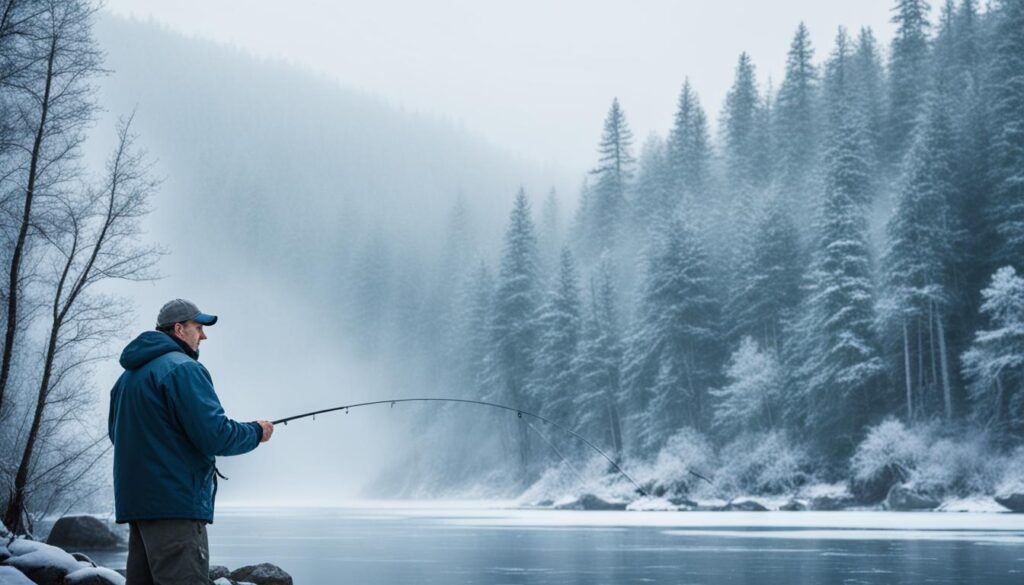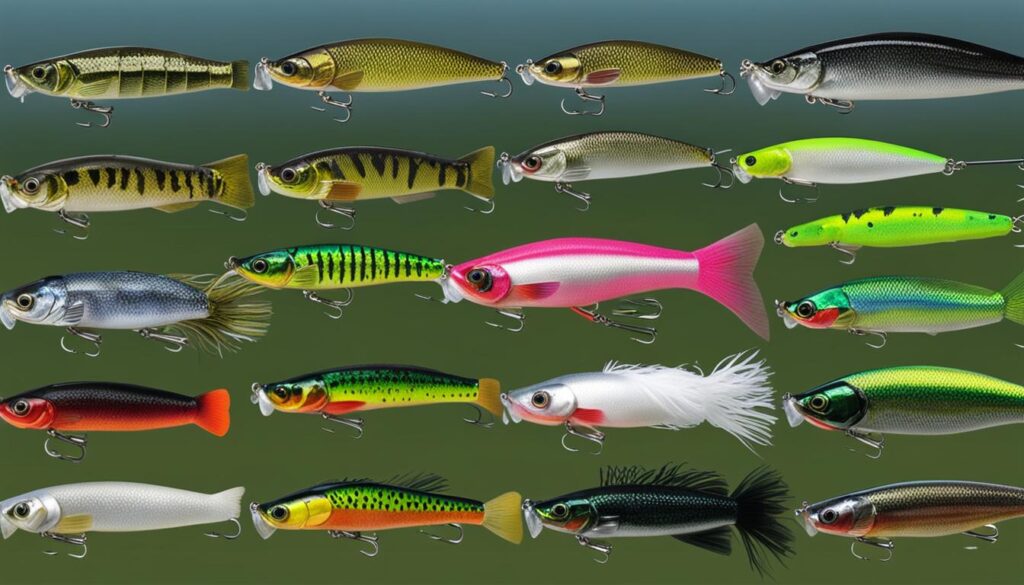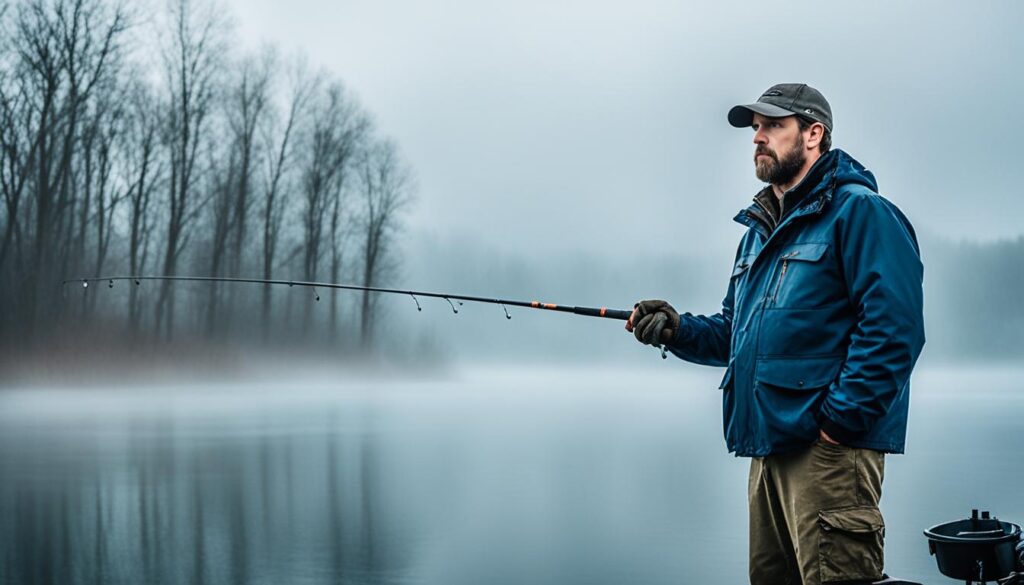Cold fronts can challenge bass fishing enthusiasts as they change fish behavior and feeding patterns. However, with the right techniques and strategies, you can adapt to these conditions and enjoy a successful fishing trip. This article will explore essential tips and techniques for fishing in cold fronts, including the best baits to use, how to adapt to changing conditions, and where to find bass during cold weather.
When facing a cold front, it’s crucial to understand how it affects bass and adjust your approach accordingly. By mastering the essentials of cold front bass fishing, you can increase your chances of landing a big catch even in challenging weather conditions. Let’s dive in and discover the secrets to success!
Angler’s Essentials:
- Cold fronts impact bass behavior and feeding patterns during fishing trips.
- Adapting to cold front conditions is crucial for a successful bass fishing experience.
- Choosing the right baits and adapting your techniques are essential to enticing bites during cold fronts.
- Understanding the impact of cold fronts helps you identify prime fishing locations.
- Tactical tips, such as adapting to changing conditions, enhance your cold front bass fishing experience.
Understanding Cold Fronts and Their Impact on Bass Fishing
Cold fronts significantly impact bass fishing, bringing about changes in fish behavior and feeding patterns. Anglers must understand the intricacies of cold fronts to adapt their fishing strategies and increase their chances of success.
When a mass of cold air replaces warm air, it results in a cold front. This phenomenon brings various effects that are crucial for bass fishing. First, there is a drop in temperature, which can significantly affect the metabolism and activity level of the bass. Second, a shift in wind direction can influence the baitfish’s movement and the bass’s positioning. Lastly, there is a change in cloud cover, which affects the amount of sunlight reaching the water and thus impacts the behavior of both bass and their prey.
These changes in temperature, wind direction, and cloud cover directly influence bass behavior and feeding patterns. Fish tend to become less active and more cautious during cold fronts, making them less likely to strike lures aggressively. They may also seek shelter or move to deeper water, making them harder to locate and catch.
By understanding the impact of cold fronts on bass fishing, anglers can adapt their techniques and strategies. This includes choosing the right lures, adjusting retrieval techniques, and targeting the appropriate areas of the water body. Awareness of temperature drops, wind shifts, and cloud cover changes allows anglers to anticipate how fish behavior may change and make the necessary adjustments.
To further illustrate the impact of cold fronts on bass fishing, consider the following:
“During a cold front, bass tend to become less active and feed less frequently. They may seek deeper water or move to areas with denser cover. This requires anglers to be patient and experiment with different lure presentations and techniques to entice bites.”
Understanding cold fronts and their impact on bass fishing is vital to successful angling during these challenging conditions. It allows anglers to adapt their strategies, increase their chances of catching fish, and ultimately enjoy a rewarding fishing experience.
Pre cold front bass Fishing Techniques
When faced with pre-cold front bass fishing, it’s essential to adjust your fishing techniques to capitalize on the increased aggression of bass and their tendency to move to shallower waters in search of food. Utilizing the right lures and employing varied retrieval techniques can maximize your chances of enticing bites during this prime feeding period.
One of the most effective lure options for pre-frontal conditions is to mimic baitfish. Crankbaits, spinnerbaits, and jerkbaits are all excellent choices when targeting aggressive bass. These lures closely resemble the prey that bass actively seek, making them more likely to strike.
Experimenting with different retrieval techniques and speeds is key to determining what works best during pre-frontal conditions. Bass may respond differently to a fast, erratic retrieval than a slow, steady one. You can identify the most successful approach for enticing bites by varying your retrieves.
Remember to adapt your techniques based on the conditions and fish behavior. Pay attention to any changes in weather patterns or fish activity and adjust your lures and retrieval techniques accordingly. Stay alert and observant, and be prepared to switch things up if you need to get the desired results.
| Lure Type | Description |
|---|---|
| Crankbaits | Designed to mimic injured or fleeing baitfish, crankbaits have a tight wobbling action that entices aggressive strikes from bass. |
| Spinnerbaits | Spinnerbaits feature rotating blades that create flash and vibrations, attracting bass in shallow waters and provoking strikes. |
| Jerkbaits | Jerkbaits imitate injured baitfish with their erratic darting action. These lures are particularly effective for triggering strikes from hungry bass. |
Combining the right lures with strategic retrieval techniques is the key to success during pre-frontal conditions. By understanding the behavior of aggressive bass and adapting to their feeding patterns, you can significantly improve your chances of landing that trophy catch.
Fishing During a Cold Front
Cold fronts can present challenges for bass anglers as they tend to make the fish more passive and less willing to bite. During a cold front, bass often seek deeper water and become less active, making it essential to adjust your fishing techniques accordingly. By employing specific strategies, such as slower retrieves, using smaller lures, or even opting for live bait, you can increase your chances of enticing a bite from reluctant bass during these challenging post-frontal conditions.
When fishing during a cold front, it’s important to remember that the fish may be less active and more selective in their feeding patterns. Here are some key tactics to consider:
- Head to Deeper Water: During a cold front, the bass often move to deeper water where they feel more comfortable—target areas with drop-offs, ledges, or structures that provide shelter.
- Slow Down Your Retrieves: Bass may be less inclined to chase fast-moving lures during a cold front. A slower retrieve can mimic the limited energy of the fish and increase your chances of triggering a strike.
- Downsize Your Lures: Using smaller lures can be effective in challenging conditions. Choose baits that closely resemble natural prey and downsize your presentation to match the fish’s reduced feeding activity.
- Try Live Bait: Live bait, such as minnows or worms, can be particularly enticing to bass during post-frontal conditions. The natural movement and scent of live bait can trigger a strike when artificial lures fail.

In conclusion, fishing during a cold front requires adaptability and a willingness to adjust your tactics. By heading to deeper water, using slower retrieves, downsizing your lures, or even trying live bait, you can increase your chances of success when targeting bass during post-frontal conditions. Remember to stay patient, observant, and willing to experiment with different approaches to find what works best in each situation.
Adapting to Post-Frontal Conditions
In post-frontal conditions, bass often seek refuge in deeper water or tight cover, making it necessary to adapt your fishing approach. During this time, finesse techniques such as drop-shot rigs, shaky heads, and ned rigs can be particularly effective in enticing bites from these cautious fish.
When fishing in deeper water, consider using a drop-shot rig. This technique keeps your bait suspended off the bottom, mimicking a natural presentation. This finesse technique can be incredibly productive when bass are held in deeper areas where the water temperature may be more stable.
Shaky heads are another finesse technique that can be employed during post-frontal conditions. This approach involves using a jighead with a finesse worm or soft plastic bait and employing subtle movements to entice bites from hesitant bass. The light wire hook and finesse-sized offerings make shaky heads a go-to for enticing bites in challenging conditions.
Ned rigs are yet another finesse technique that can help you adapt to the challenges of post-frontal conditions. The ned rig comprises a mushroom-shaped jighead and a small soft plastic stick bait. This combination provides a subtle presentation that can tempt even the most finicky bass.
Experimentation is Key
Experimenting with different lures, colors, and presentations is crucial when fishing in post-frontal conditions. Bass are often more cautious and selective in feeding during this time, so it’s important to try various combinations to determine what will entice them to bite.
“In post-frontal conditions, bass tend to be more cautious and selective in their feeding. By experimenting with different finesse techniques and lures, anglers can increase their chances of success.” – Bass Pro
When selecting lures, opt for subtle, natural colors that mimic the forage available in the area. Bass in post-frontal conditions are less likely to chase after flashy or aggressive presentations, so finesse is critical.
Post-Frontal Conditions Table
| Finesse Techniques | Description |
|---|---|
| Drop-shot rigs | A finesse technique where the bait is suspended above the bottom using a specialized rig, mimicking natural movements. |
| Shaky heads | A finesse technique using a jighead with a soft plastic bait, employed with subtle movements to entice bites. |
| Ned rigs | A finesse technique consisting of a mushroom-shaped jighead paired with a small soft plastic stick bait, providing a subtle presentation. |
Choosing the Right Lures for Cold Front Bass Fishing
Selecting the right lures is crucial for maximizing your success in cold front bass fishing. Understanding each lure’s characteristics and optimal use can significantly improve your chances of catching bass during these challenging conditions. Here are some critical lures to consider:
Rattles and Silent Baits
Rattles and silent baits are practical tools for capturing the attention of passive bass during a cold front. The added sound and vibration can entice bass to strike, even when less active. You can just experiment with different rattling or silent baits to see what works best in your fishing area.
Jigging Spoons
Jigging spoons are excellent lures for targeting bass schools in deeper water during cold fronts. The spoon’s erratic motion mimics injured baitfish, triggering the bass’s predatory instincts. Cast out your jigging spoon and experiment with different retrieve speeds and pauses to entice strikes.
Jig and Pig Rigs
Jig and pig rigs are another practical option for catching bass during cold fronts. This combination of a weighted jighead and a pork trailer creates a realistic baitfish presentation that can entice strikes from sluggish bass. Vary your retrieve speed and try different colors to find the combination that appeals most to bass in your fishing area.
Remember, the choice of lures will ultimately depend on the specific conditions you are facing and the behavior of the bass in your fishing area. Experimenting with different lures and presentations is essential to find what works best for you. Here’s a table summarizing the characteristics and use of each lure:
| Lure | Characteristics | Optimal Use |
|---|---|---|
| Rattles and Silent Baits | Produces sound and vibration | Attract lethargic bass during cold fronts |
| Jigging Spoons | Mimics injured baitfish | Targets bass schools in deeper water |
| Jig and Pig Rigs | Realistic baitfish presentation | Entices strikes from sluggish bass |

Selecting the right lures and understanding their optimal use will increase your chances of success in cold-front bass fishing. Stay adaptable and experiment with different techniques to find what works best for you. Happy fishing!
Prime Locations for Cold Front Bass Fishing
Identifying prime locations is crucial for successful cold front bass fishing. Understanding where bass seeks refuge and feed during these conditions can significantly increase your chances of a successful catch. Here are some prime locations to target:
- Northern shorelines: Bass are often drawn to northern shorelines during cold fronts due to their exposure to sunlight. These areas provide warmth and attract baitfish, making them ideal spots to target.
- Big lakes and creeks: These larger bodies of water offer various options for finding bass in different depths and conditions. With ample space and cover, they are worth exploring during cold fronts.
- Shallow water with dense cover: Shallow areas with thick cover, such as mats and weed beds, provide a sanctuary for bass seeking shelter and food. These spots can be highly productive during cold fronts.
Focusing your efforts on these prime locations will make you one step closer to landing the trophy bass you’ve dreamed of.
Tactical Tips for Cold Front Bass Fishing
Cold front bass fishing requires a strategic approach to maximize your chances of success. Here are some tactical tips to help you adapt and improve your catch during these challenging conditions:
1. Make Multiple Presentations
When fishing on cold fronts, you must vary your lure presentations. Bass may be less active and more selective during this time, so experimenting with different techniques can increase your chances of enticing a bite. Try changing the retrieve speed, using different depths, and incorporating pauses or twitches to mimic wounded prey. You can find the most effective method for enticing bass in these challenging conditions by making multiple presentations.
2. Be Present and Adaptable
Fishing in the moment and adapting to changing conditions is crucial for cold front bass fishing. Be observant and responsive to changes in fish behavior, water temperature, or weather patterns. Pay attention to subtle cues and adjust your approach accordingly. This can involve changing lures, fishing deeper or shallower, or targeting specific areas where bass are actively feeding. By staying present and adaptable, you can increase your chances of success.
3. Fish During the Best Times and Locations
Timing is critical when fishing during cold fronts. Bass are more likely to be active and feed during certain times, such as early morning or late afternoon, when temperatures may be slightly warmer. Additionally, focusing on prime locations will increase your chances of encountering bass. Look for areas with structure, such as rocks, submerged trees, or drop-offs, as these provide hiding spots and ambush opportunities for bass. Shallow water areas with dense cover, such as weed beds and mats, are also worth exploring.
4. Use Lighter Line and Smaller Lures
Cold front bass fishing often requires finesse and precision. Switching to a lighter line and downsizing your lures can make a significant difference in enticing bass during these challenging conditions. A lighter line offers better sensitivity, allowing you to detect subtle bites and make precise presentations. Smaller lures mimic the natural forage that bass may feed on during cold fronts. Consider using smaller soft plastics, finesse jigs, or smaller crankbaits to match the size and behavior of the prey bass are targeting.
5. Adapt to Changing Conditions
As cold fronts move through, conditions can change rapidly. Be prepared to adapt your strategies and techniques accordingly. If the weather becomes even colder or windier, bass may seek deeper water or tighter cover. In these situations, finesse techniques such as drop-shot rigs, shaky heads, or ned rigs can effectively entice bites. Keep an eye on water clarity and adjust lure color and presentation to maximize visibility and appeal to bass. Flexibility and adapting to changing conditions are key to success during cold front bass fishing.
| Tactical Tips for Cold Front Bass Fishing |
|---|
| Make Multiple Presentations |
| Be Present and Adaptable |
| Fish During the Best Times and Locations |
| Use Lighter Line and Smaller Lures |
| Adapt to Changing Conditions |

Implementing these tactical tips will help you enhance your cold front bass fishing experience. By making multiple presentations, being adaptable, fishing during the best times and locations, using lighter lines and smaller lures, and adapting to changing conditions, you’ll increase your chances of success even when faced with challenging weather conditions. Remember to stay patient, observant, and open to experimentation. Good luck on your next cold front fishing adventure!
Conclusion
In conclusion, cold front bass fishing requires unique skills and strategies to overcome the challenges presented by changing weather conditions. By understanding the impact of cold fronts on fish behavior, anglers can adapt their techniques and increase their chances of success.
By adjusting lure selection to match the preferences of lethargic bass and targeting prime locations such as northern shorelines and areas with dense cover, anglers can increase their chances of landing a trophy bass even during the most challenging conditions. Additionally, being adaptable and patient is critical, as cold fronts may require changes in approach and tactics.
So, whether you’re fishing during pre-frontal or post-frontal conditions, remember to stay informed, experiment with different techniques, and maintain resilience. Armed with your newfound knowledge of cold front bass fishing, you can embrace the challenges and rewards that await you on the water. Good luck, and happy fishing!
FAQ
What is a cold front, and how does it affect bass fishing?
A cold front occurs when a mass of cold air replaces warm air, leading to changes in temperature, wind direction, and cloud cover. These conditions significantly impact bass behavior and feeding patterns, making them more challenging to catch.
What fishing techniques are effective during pre-frontal conditions?
Bass tend to be more aggressive and feed in shallow water before a cold front. Using lures like crankbaits, spinnerbaits, and jerkbaits that mimic baitfish can be effective. Varying retrieval techniques and speeds can help entice bass during this time.
How should I fish during a cold front?
Cold fronts often make bass more lethargic, causing them to seek deeper water. Adjust your fishing techniques by using slower retrieves, smaller lures, or even live bait to entice bites from less active bass.
Where do bass go during post-frontal conditions, and how can I adapt my fishing approach?
Post-frontal conditions may push bass to seek refuge in deeper water or tight cover. Using finesse techniques like drop-shot rigs, shaky heads, or ned rigs can help entice bites in these challenging conditions.
What are some recommended lures for cold front bass fishing?
Rattles and silent baits are effective in capturing the attention of lethargic bass during cold fronts. Jigging spoons and jig and pig rigs are ideal for targeting bass schools in deeper water.
Where are the prime locations for cold front bass fishing?
Northern shorelines with ample structure and cover, big lakes and creeks, and shallow water areas with dense cover like mats and weed beds are prime locations to target bass during cold fronts.
What are some tactical tips for cold front bass fishing?
Making multiple presentations with different lure techniques can increase your chances of enticing bites. Being present and adaptable in your fishing, using lighter line and downsized lures, and fishing during the best times and in optimal locations are all tactical tips for cold front bass fishing.
How can I improve my success in cold front bass fishing?
Understanding the impact of cold fronts on fish behavior, adjusting your techniques and lure selection, targeting the right locations, and being adaptable and patient are all key to improving your success in cold front bass fishing.
